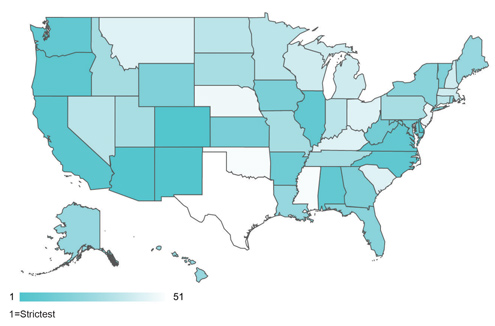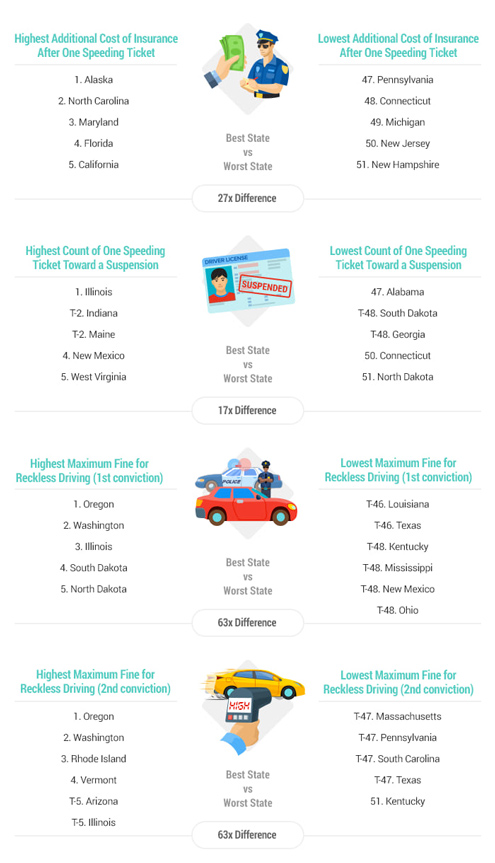Alina Comoreanu, Senior Researcher
July 5, 2018
Speed kills. We have all been told that since driver's education class, and yet American drivers routinely exceed the speed limit. Before you underestimate the danger of exceeding the speed limit, consider that in 2016 speeding was a factor in 27 percent of motor vehicle crash deaths.
Speeding is costly, too. The National Highway Traffic Safety Administration estimates that the annual economic cost to society of speeding related crashes is $40.4 billion.
Another important issue is the impact of speeding on fuel consumption. According to the U.S. Department of Energy (DOE), as a rule of thumb, you can assume that every 5 mph you drive over 60 mph will cost you 7 percent more for gasoline.
Some states are tougher on speeding and reckless drivers than others. To find out which states take the hardest line on dangerous driving behavior, WalletHub compared driving laws in all 50 states and the District of Columbia. The results and our detailed methodology, along with expert commentary, can be found in the pages below.
Main Findings

Strictest States on Speeding and Reckless Driving
Overall Rank (1=Strictest) |
State |
Overall Score |
Reckless Penalties Rank |
Speeding Enforcement Rank |
|---|---|---|---|---|
1 |
Delaware |
20.00 |
1 |
8 |
2 |
Colorado |
18.00 |
2 |
11 |
T - 3 |
Arizona |
17.00 |
7 |
2 |
T - 3 |
New Mexico |
17.00 |
7 |
2 |
5 |
California |
16.50 |
4 |
11 |
6 |
Oregon |
16.00 |
6 |
8 |
7 |
North Carolina |
14.50 |
12 |
5 |
T - 8 |
Illinois |
14.00 |
16 |
4 |
T - 8 |
Virginia |
14.00 |
25 |
1 |
T - 8 |
Alabama |
14.00 |
7 |
19 |
T - 8 |
Washington |
14.00 |
12 |
8 |
12 |
Arkansas |
13.50 |
3 |
40 |
T - 13 |
West Virginia |
12.50 |
5 |
36 |
T - 13 |
MaryLand |
12.50 |
25 |
5 |
15 |
Kansas |
12.00 |
7 |
32 |
16 |
Iowa |
11.50 |
22 |
17 |
T - 17 |
Wyoming |
11.00 |
11 |
32 |
T - 17 |
Vermont |
11.00 |
12 |
29 |
T - 17 |
Georgia |
11.00 |
25 |
17 |
T - 20 |
District Of Columbia |
10.50 |
34 |
11 |
T - 20 |
New York |
10.50 |
41 |
5 |
T - 20 |
Florida |
10.50 |
34 |
11 |
T - 20 |
Rhode Island |
10.50 |
25 |
19 |
T - 24 |
Hawaii |
10.00 |
25 |
23 |
T - 24 |
Alaska |
10.00 |
16 |
29 |
T - 24 |
Louisiana |
10.00 |
40 |
11 |
T - 24 |
Maine |
10.00 |
16 |
29 |
28 |
Idaho |
9.50 |
12 |
40 |
T - 29 |
Missouri |
8.50 |
41 |
19 |
T - 29 |
Tennessee |
8.50 |
41 |
19 |
T - 29 |
Pennsylvania |
8.50 |
45 |
11 |
T - 29 |
South Dakota |
8.50 |
16 |
40 |
T - 29 |
Utah |
8.50 |
25 |
32 |
T - 34 |
Indiana |
8.00 |
41 |
23 |
T - 34 |
Connecticut |
8.00 |
25 |
36 |
T - 34 |
Minnesota |
8.00 |
25 |
36 |
T - 34 |
Nevada |
8.00 |
22 |
40 |
T - 34 |
North Dakota |
8.00 |
22 |
40 |
T - 39 |
Massachusetts |
7.00 |
34 |
36 |
T - 39 |
New Hampshire |
7.00 |
16 |
49 |
T - 39 |
Michigan |
7.00 |
16 |
49 |
T - 39 |
Wisconsin |
7.00 |
45 |
23 |
T - 43 |
Kentucky |
6.50 |
45 |
26 |
T - 43 |
Montana |
6.50 |
33 |
45 |
T - 43 |
Ohio |
6.50 |
45 |
26 |
T - 43 |
South Carolina |
6.50 |
45 |
26 |
T - 47 |
Nebraska |
6.00 |
34 |
45 |
T - 47 |
New Jersey |
6.00 |
34 |
45 |
T - 49 |
Oklahoma |
5.50 |
34 |
48 |
T - 49 |
Mississippi |
5.50 |
45 |
32 |
51 |
Texas |
2.50 |
45 |
51 |

Ask The Experts
To understand the total cost of speeding to society, and what can be done to reduce its occurrence, we consulted a panel of traffic safety experts below. Following are the questions we asked.
 |
Virginia P. Sisiopiku Associate Professor of Transportation Engineering and Director of the Transportation Program at The University of Alabama at Birmingham |
As traffic worsens in many cities, drivers' tempers get shorter. What can states do to reduce road rage and aggressive driving?
States can implement a 3-E approach to address the problem. The 3-E refers to Engineering, Education, and Enforcement.
Engineering interventions are necessary to reduce the frequency and extent of traffic congestion. The use of new technologies as well as options that redistribute traffic demand over space and time can be effective countermeasures to reduce congestion and congestion related impacts, including driver delays and frustration.
Education of drivers about the negative effects of aggressive driving on traffic operations and safety is also important. As drivers understand better their rights and responsibilities when sharing the road with others, road rage and irresponsible driving are both less likely.
Last but not least, enforcement is a tool to combat aggressive driving and other irresponsible driving behaviors. For instance, studies clearly show the reduction of red light running or speeding in the presence of automated enforcement using cameras. In fact, research confirms that drivers tend to commit fewer violations, not only at enforcement sites, but also at locations in the vicinity of such sites.
Average highway speeds are much higher now than in the days of the national 55 mph speed limit. How has this affected efforts to reduce fuel consumption?
A study by the Transportation Research Board in the 80's revealed that an increase of the speed limit from 55 to 65 would result in an increase of the national fuel consumption by .018 percent. As reported by U.S. News: "Saving less than two tenths of one percent in fuel consumption seems a poor tradeoff for putting 200 million motorists through the misery of going back to a 1930s speed limit."
Keeping in mind that only 1.2 percent of the nation's 3.8 million roadway miles are interstate highway, one can see that maintaining a speed limit of 55mph on interstate highways can have only a limited effect on reducing fuel consumption.
Thus, in the recent years, efforts to reduce fuel consumption have shifted from adjusting the national speed limits to creating more efficient vehicles, introducing hybrid vehicles and alternative fuel use vehicles, and promoting use of transit alternatives and non-motorized modes.
What road design & traffic calming measures have been shown to be effective at reducing speeding?
Traffic calming is the combination of mainly physical measures that reduce the negative effects of motor vehicle use, alter driver behavior and improve conditions for non-motorized street users.
Traffic calming involves changes in street alignment, installation of barriers, and other physical measures to reduce traffic speeds and/or cut through volumes in the interest of street safety, livability, and other public purposes.
Commonly used traffic calming techniques include raised pavement areas, speed humps, reduced street areas, curb extensions, street closures, traffic diverters, roundabouts, to name a few.
Before and after studies at multiple retrofitted locations show an average reduction in speeds by 7.6mph (22% reduction) due to the introduction of 12' humps. Half closures led to 6mph lower speeds (19% reduction) while replacement of a cross intersection by a roundabout resulted in nearly 4% reduction in speeds (11% reduction).
 |
Kara Kockelman E.P. Schoch Professor in Engineering in the Department of Civil, Architectural & Environmental Engineering at University of Texas at Austin |
As traffic worsens in many cities, drivers' tempers get shorter. What can states do to reduce road rage and aggressive driving?
Allowing other drivers to report license plate numbers of reckless driving behaviors (along with other basic information, like time of day, type of vehicle, and roadway where behavior occurred) can be a helpful policy. Other infractions (e.g., pickup trucks and SUVs that have their hitch point out [which causes a lot of bumper damage in parking lots and to any following car who gets too close], excessively tinted windows, smoking tailpipes) can also be reported at such websites, and letters issued to warn the vehicle's registered owner that complaints are being filed. This practice makes drivers more accountable, helping reduce the anonymity and other protection that many feel on today's roads, which has helped foster poor behaviors.
Average highway speeds are much higher now than in the days of the national 55 mph speed limit. How has this affected efforts to reduce fuel consumption?
Modern day vehicles maintain maximum fuel economy up to speeds of 60 or 65 mi per hour, but 70 and 75 mph travel is less efficient. Stop-and-go driving under congested conditions and aggressive acceleration on ramps and elsewhere result in some of the poorest fuel economy, however. It is important to moderate one's behavior, and simply buy a more fuel-efficient vehicle. We are very fortunate that the current Administration takes fuel economy seriously, and CAFÉ laws were changed the first month President Obama took office. If Americans were perfectly rational consumers, most would be buying hybrid versions of their vehicles. And, if people care about their grandchildren's and other people grandchildren's inherited climate, they'd be driving much smaller vehicles, hybrids, electric or plug-in hybrids.
What road design & traffic calming measures have been shown to be effective at reducing speeding?
Speeds go down with road humps and bumps, but those can be tough on patients in the back of an ambulance and are simply not advisable for higher speed roadways. Curvature, narrowed lanes, limited sight distances, and roundabouts (rather than green lights) can also bring down speeds, while waking up drivers, so they are less likely to nod off or be distracted. But they have to have forgiving edges and such, to avoid creating some dangerous crashes. Europe has far more experience with such techniques than the U.S.
Young drivers have a harder time resisting the temptation to drive fast. What steps can states and parents take to help new drivers learn safe driving habits?
Graduated licensing laws have had very serious benefits in helping young drivers become more experienced before taking on more complicated driving. Disallowing young drivers on freeways and high-speed highways may be helpful, but some home locations have few options for destinations if their residents cannot enter a high-speed roadway. Smartphone apps allow parents to see travel speeds of their children, and more automated cars probably will allow for speed "governors" (to be placed on a vehicle when the owner wishes to limit top speeds - of his/her children, for example). Eventually, smart cars may not allow certain exceedance levels of speed limits, everywhere in the network, depending on the restrictions the owner sets, which can help protect young drivers (& everyone else) from themselves.
 |
Francois Dion Ph.D Senior Development Engineer at Partners for Advanced Transportation Technology (PATH), University of California, Berkeley |
As traffic worsens in many cities, drivers' tempers get shorter. What can states do to reduce road rage and aggressive driving?
This is a difficult problem to tackle, as road rage may also be affected by cultural changes, such as the rise of a more self centered culture which can lead to a decrease in courtesy and civility. In many cases, tempers get shorter because we do not know what is happening, why there is congestion. A practical solution to help reduce temper flaring has been to provide motorists with more information about road condition ahead, such as travel times to reference points, location of incident ahead, etc. - since motorists know what to expect, they tend to remain calmer. However, the provision of such information is often constrained by a limited number of means to disseminate information, few freeway electronic signs for instance.
Average highway speeds are much higher now than in the days of the national 55 mph speed limit. How has this affected efforts to reduce fuel consumption?
My understanding is the 55 mph national speed limit was imposed as a means to reduce fuel consumption after the fuel shortage crisis of the mid-1970s. The problem with this law is that it was largely disregarded, and was seen as an annoyance and impediment to economic activities.
Gas prices have probably been a more effective influencing factors to improve vehicle fuel consumption, as price spikes have pushed motorists to buy smaller cars or more fuel efficient vehicles. The 55 mph was probably more effective in reducing accidents and fatalities than at reducing fuel consumption. Slower speeds means less severe accidents. .
What road design & traffic calming measures have been shown to be effective at reducing speeding?
Various measures have been used effectively:
Young drivers have a harder time resisting the temptation to drive fast. What steps can states and parents take to help new drivers learn safe driving habits?
In this case, I think that education is the key. Young drivers need to know the risks associated with speeding. Since they have a lack of driving experience, it is difficult for them to fully appreciate the risks, accident and injury risks to themselves or others, not to mention potential high monetary costs associated with accidents. Graduated licenses, where younger drivers have few demerit points, also probably help.